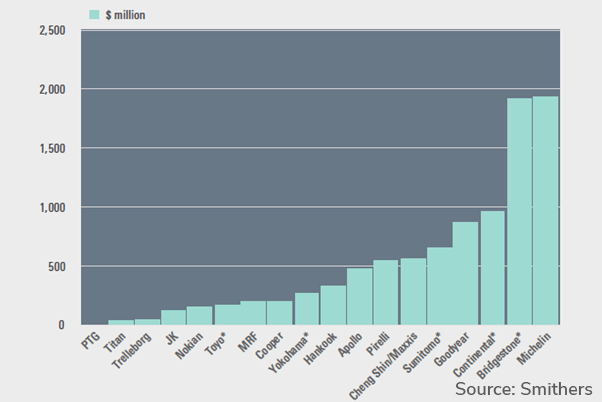Market Report
The Future of Tire Manufacturing to 2024



Production planning in the tire business has changed greatly since 2000as the number of sub-brands and sizes has multiplied. Customers are demanding quicker delivery times so the order–delivery cycle has become shorter and warehouses no longer fill with products.
Tire manufacturers have to balance their production runs with orders, however and shorter product runs and complex product mixes present challenges for planning and day-to-day factory operation.
For a tire plant to be efficient, a good production plan is a crucial basis for material flow planning. Although the challenges, threats and possible pitfalls differ between brownfield and greenfield projects; an extensive, analytical and forward-looking production plan is key whenever a new process is created.
With the increased number of tire sizes, it is still possible to moderate the number of semi-finished products, if modulation is an option. Not every tire requires specific components and modularising is a good solution, for instance, with steel belts and carcass components.
Rounding tire widths slightly up or down can be a small, but highly effective, way of cutting further the number of separate products help in a plant’s inventory.
Modularisation should be systematic and planned with professional partners as it can increase productivity remarkably, even with a challenging product mix, and minimal or no investment.
For a given plant, especially a greenfield site, tire companies are increasingly moving away from multi-size and multi-type tire production. This allows for the specialisation of processes and equipment suited to a particular size or type of tire, and can greatly decrease complexity and boost efficiency.
Compounding, mixing and some component preparation, are increasingly being outsourced – leading to a situation where some modern tire manufacturing facilities are more focussed on producing tire from materials and components sent from multiple outsourced locations.
In a global market space this aligns with the tendency fir tire companies to produce closer to OEM vehicle assembly plants. This approach saves on transportation costs and shipping/time to market, while avoid certain current and potential future trade restrictions or tariffs; and it is set to increase in the future, particularly given current trade agreement uncertainties between the US and China.
Automation continues to be one of the critical factors in helping tire manufacturers meet the challenges of global competition and consolidation, technology innovation and obsolescence management. The combination of automation with smart artificial intelligence software – including learning algorithms – has been described as a fourth industrial revolution, or Industry 4.0.
This is an area where significant progress is being made, mainly in the most developed markets. Automation may be applied to an entire plant or to specific manufacturing process equipment, such as a tire-building machine.
At plant level, there has been much activity to upgrade old factories and design new ones around automation. To remain competitive, manufacturers in the US are automating their existing facilities, though this can be a significant challenge with plant layouts built for manual processes.
Full-plant automation can gives multiple benefits – lower stock levels, optimisation of space, minimisation of buffer stock, as well as the potential for full traceability of every tire in production. Cumulatively these can lead to in high-quality tires and better yield, but does place a stress on more uniformity in materials, and for grades that are more suited to automatic handling.
The introduction of embedded RFID chips and sensors in tires has had many implications for vehicles in use with smarter and automated driving platforms. The same technology can be a benefit on the factory floor as well. Its use in complementing barcodes giving the industry improved insight and a greater range of conveniences.
RFID tags can store important data – such as tire make, size, or type – that can be quickly read and thus dovetails with the trend towards greater automation. Unlike a barcode label, RFID tags can be read, even when obscured by other objects, or when embedded in the tire itself.
Major tire equipment and automation suppliers – such as Mesnac and Rockwell Automation – are active in spreading this technology; as are smaller more specialised companies, such as Computype.
While RFID and sensors in tires can assist manufacturing, adoption is likely to be slow unless is a specific impetus from new regulatory requirements. Its initial use will be seen widely in more expensive segments, such as off-the-road, truck and bus tires.
The Future of Tire Manufacturing to 2024 provides critical industry insight, with volume and value production of all major grades of tires across the next five years. This supported by analyses of the leading technology and market trends, with data on major company production capacities and planned expansions given for each world region.